In keeping with our home library emphasis this month, most of our readers would probably agree that the first items on our list would be Bibles, Bible Story books, and Bible References. But if you type in any of those categories in Amazon.com, be prepared for the deluge. How do you pick and choose among the multitude of books vying for your attention? “Buying Your First Story Bible” was Emily’s premiere post on our blog, and you can be sure we’ll be re-visiting the subject periodically. For this post, I took a trip to my local Mardels and Barnes & Noble to see what they had in the Story-Bible department–meaning this is by no means a comprehensive survey. Some of these titles have been around awhile and may even now be occupying space on your shelves. Two are brand-new. Most are readily available, but may not be the best choice for your family. I would recommend further research before making a decision, but here’s my take on the popular, the new, the classic, and the true-blue, going up by target age:
My Story Bible: 66 Favorite Stories, by Jan Godfrey and Paola Bertolini Grudina. Tyndale Kids, 2009, 144 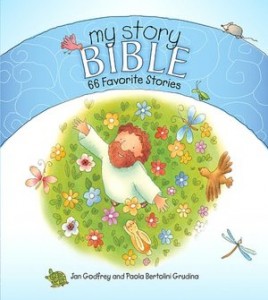 pages. Age/interest level: 3-up.
pages. Age/interest level: 3-up.
There’s a lot to like about this book: the text is warm and conversational and illustrations (which are very important; more about this later) are gentle pastels with friendly-looking characters appropriate to this age group. Some liberties are taken in an effort to make brief tales more like stories, with characters and all (“Oh dear oh DEAR, thought Martha, growing more and more worried and flustered. This meal will never be ready for Jesus!”). I like that it includes “The Promise of a King” in the lineup of 66: Isaiah’s prophesies of Jesus, which are often overlooked in Old Testament storybooks for the very young. But there’s an inexplicable omission: From “God Made the World” we abruptly go to “Noah Builds a Boat,” with no account of the fall. Noah’s story begins with, “God told Noah it was going to rain very hard”–with no particular reason why. Would it be battering little sensitivities too much to say something like God told Noah he was going to flood the earth because people were doing such terrible things? I know that very small children don’t need to be introduced to the world’s horrors, but even toddlers know there’s something wrong with this old world. And they should already have personal experience with sin and consequences, even if they don’t know the terminology. Without the Fall, none of the rest makes any sense. If your budget does not allow for more than one Bible storybook, I would recommend passing on this one.
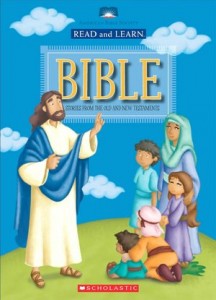 The Read and Learn Bible, by Eva Moore, Illustrated by Duendes Del Sur. Scholastic (with the American Bible Society), 2005, 544 pages. Age/interest level: 4-up.
The Read and Learn Bible, by Eva Moore, Illustrated by Duendes Del Sur. Scholastic (with the American Bible Society), 2005, 544 pages. Age/interest level: 4-up.
The story selection is expanded to 102, with welcome additions such as Micah and Jeremiah. The Tabernacle and the Temple are vital to the redemption narrative, so it’s good to see them addressed here. Quoted texts are from the Contemporary English version. Each story includes words or phrases printed in bold, and ends with a little box that defines or elaborates on those terms. For instance, when the snake tempts Eve to eat the fruit, the annotation explains that “the snake is tempting Eve with the desire to be like God and know what God knows.” That’s a nice touch, and a series of “Parent and Children” pages at the end offer further scripture passages and story examples for 16 special topics, such as Serving Others, Facing Fears, Sharing Gifts, Redemption, Worship, Prayer, etc. The American Bible Society co-published this book, and it’s more true to the original than some others which freely extrapolate. In the Table of Contents, stories are organized under the name of the Bible book in which they appear, making it a little easier to see where individual characters and events fit into the whole. With simplified language, large text and not too many words on a page, the stories can be read by a second grader. The illustrations are more realistic than some story Bibles, but not especially memorable: more like standard Sunday-school pictures. Overall, though Read & Learn may be a good choice for beginning readers.
The Beginner’s Bible, Illustrated by Kelly Pully, Zonderkidz, 2005, 512 pages. Age/interest level: 4-up.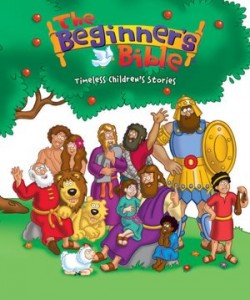
“Full of Life and Fun!” reads the tagline. The “fun” is supposedly supplied through the illustrations, featuring grinning characters with eyes that look like ping pong balls. Cartoony illustrations are supposed to appeal to children, but that doesn’t mean they’re always appropriate. To me it shows a lack of careful consideration, as though common wisdom dictates that “kids like comic pictures,” so we oblige them regardless of subject. It should go without saying but pictures form a child’s first impression—in fact, pictures form an adult’s first impression. Dressing up a newsletter with some clip art doesn’t take a lot of consideration, but introducing the eponymous beginner to God’s word requires the publisher to think carefully about how a three-year-old is going to picture Abraham or David or Christ Himself after the book is closed. Pictures don’t have to be strictly realistic—Jago’s illustrations for The Jesus Storybook Bible and Carolina Faritas’ for Jesus Calling (below) are highly stylized yet communicate a sense of surprise, joy, and beauty. These are just goofy. (Parents and older kids may see some glaring inaccuracies, too, such Rebecca in a modern-looking white dress and veil for her wedding to Isaac.) The text, designed for older children to read themselves, doesn’t seem to have a lot of extra-biblical fillips, and deserves credit for that. But the pictures take away more than they add.
 The Jesus Calling Bible Storybook, by Sarah Young, Illustrated by Carolina Faritas. Thomas Nelson, 2012, 256 pages. Age/interest level: 4-up
The Jesus Calling Bible Storybook, by Sarah Young, Illustrated by Carolina Faritas. Thomas Nelson, 2012, 256 pages. Age/interest level: 4-up
Speaking as one who’s rather leery about the author’s phenomenally successful Jesus Calling devotional guide (here are Tim Challies’ thoughts on it), I liked the Bible storybook better than I expected to. Its strength is the presence of Christ, who asserts himself at the very beginning as the Alpha and Omega of scripture. Like Susan Lloyd Jones in The Jesus Storybook Bible, Sarah Young finds echoes of Christ throughout the Old Testament. After Adam and Eve are driven out of the garden: “God had a plan. He would come to earth as a baby and grow to be a man who would defeat Satan and rescue God’s children.” After Noah: God knew bad things would happen again. But He already had another plan . . .” Unlike most story Bible authors (especially for this age group), she does not shy away from the story of Abraham and Isaac: “One day God would sacrifice His own son . . .” But she adds her own little interpretations. Here’s Abraham with the knife in his hand: “’God,’ said Abraham, with tears in his eyes, ‘if you want my only son, here he is.’” That might have been the sentiment; Genesis is maddeningly silent on how Abraham was feeling throughout this whole episode. But the author of Hebrews indicates his faith that Isaac would somehow be returned to him. Authorial license is touchy when applied to sacred scripture, but sometimes it can flash new light on an oft-told tale:
Then it happened. God poured all of His people’s sin—in the past, now and forever—into Jesus’ heart. “Father!” Jesus cried. “Don’t leave me!” But God had to turn away from all that sin. But it wasn’t His sin. It was ours. Jesus felt it and suffered for it so we wouldn’t have to. Right then, the world changed forever.
So far so good. Where parents might take warning is the “Jesus calling” paragraph at the end of each story, where the Lord Himself speaks to the reader: “If you listen closely you will hear me in your heart. Find a quiet place and be still. I will speak to you softly and tenderly.” What’s wrong with this? Aren’t we supposed to “Practice the Presence of God?” (The classic work by Brother Lawrence is back in vogue: I’ve had two people mention it to me in the last couple of weeks.) Of course we are. But I’m not comfortable with hearing the voice of Jesus mediated through Sarah Young, especially when He’s already chosen the Word and the Spirit as mediators. I also believe that the Holy Spirit ministers the word to us individually, in ways suited to each person. If your children can read the stories without the added tete-a-tetes the book would probably benefit them. Otherwise, I’m not so sure.
Totally Awesome, SuperCool Bible Stories as Drawn by Nerdy Ned. Thomas Nelson, 2012, 240 pages. Ages  6-up.
6-up.
I’m not sure who Nerdy Ned is, but Thomas Nelson seems to be capitalizing on the dearth of Bible storybooks for ‘tweeners, as well as the success of Wimpy Kid, Big Nate, and other middle-school underachievers. The format is reminiscent of those classic works: crude line drawings, sidebar annotations, ultra-conversational tone. Sample story titles: “Elijah’s Hot Ride,” “Stephen: Bully Magnet,” “Lion with Lockjaw,” “Plague-a-palooza.” Obviously the intention is to make the Bible seem more accessible to today’s youngster, and it may work well enough with kids who don’t know much Bible or Christianity. In a swift perusal I didn’t see anything about Jesus until the New Testament: the seminal prophesy of Gen. 3:15 is passed over, Isaac (the forestalled sacrifice) is omitted, and the Ten Commandments are presented as God’s rules for being good. Occasionally the text scores a hit, as when Jesus’ disciples failed to keep watch with him in the garden:
I get steamed when I read this story. Not cool, disciples. Not cool. But then I think to myself, Ned, how many times have you not done the simplest thing God asked you to do?
Ned, do you realize this is because there’s no way you can obey God without the power of the Holy Spirit and the atoning blood of Jesus Christ? Our narrator gets the basic story straight but goes a bit squishy on the implications. Readers are invited to copy the quasi-comic drawings and add their own notes, but I’m not sure how either text or illustrations will stimulate further creativity. And besides (here’s the elephant in the room), by the time they reach the target age for this book, kids should probably should be reading the Bible on their own. The International Children’s Version should be accessible to most ‘tweeners–but God willing, I’ll have more to say about that on Friday.
Then there are the classics . . .
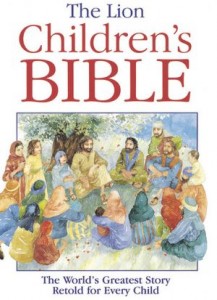 The Lion Children’s Bible, by Pat Alexander, illustrated by Carolyn Cox. Lion Hudson, 1981 (reprinted 2004, distrib. in USA by Independent Publishers Group), 256 pages. Age/interest level: 8-up.
The Lion Children’s Bible, by Pat Alexander, illustrated by Carolyn Cox. Lion Hudson, 1981 (reprinted 2004, distrib. in USA by Independent Publishers Group), 256 pages. Age/interest level: 8-up.
The Children’s Bible in 365 Stories, by Mary Batchelor, illustrated by John Haysom. David C. Cook, 1985, 416 pages. Age/interest level: 8-up
This may be a comment on the frivolous character of our age, but I find the older Bible storybooks generally to be more serious-minded and straightforward. The Lion Children’s Bible has been popular in the UK for decades (4 million copies sold worldwide, according to the PR), but I probably wouldn’t be mentioning it if Independent Publishers Group hadn’t send me a copy. I’m glad they did; for the most part, I like it. It treats all the major stories of the Old Testament—including Isaac on the altar and David and Bathsheba, which most children’s storybooks won’t touch (“He ordered his servants to bring Bathsheba to the palace, and he made love to her.”). Because the scope extends to Jeremiah, Hezekiah, Josiah, Ezekiel, etc., the reader gets a good idea of the sweep of Bible history. I also appreciate the attention paid to the tabernacle and sacrificial system. However, prophesy is slighted—why no Isaiah?—and even though the introductory page presents an excellent summary of the Old Testament (“God 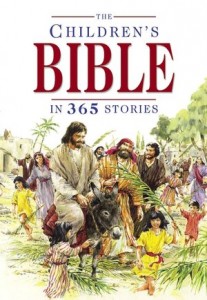 chose one man, and through him a nation, and from that nation a Saviour”) we don’t see the Savior prefigured. The book is a handy size that can be packed and carried easily.
chose one man, and through him a nation, and from that nation a Saviour”) we don’t see the Savior prefigured. The book is a handy size that can be packed and carried easily.
The Children’s Bible in 365 Stories is much longer and more comprehensive, as might be guessed by the title. I’ve always loved the pictures, realistic water-color depictions that are often dramatic and eye-catching, even beautiful. Though recommended for children as young as four, the narrative style may be a little too challenging for that age; I would wait until they’re older. Because of the format it can serve as a devotional guide, with a story for every day of the year. Some of the more disturbing stories are included, such as Jephtha’s Daughter and Jael’s Tent Peg, but there’s also space given to the Psalms and Proverbs. Again, Jesus is not prefigured much, though there’s a section on prophesy just before the story of his birth. Some readers have complained of authorial license, but I don’t see a big problem here. Classic, basic, a little too hefty to carry around, but a good size for home use, whether for bedtime stories or for wiling away a rainy afternoon.
Some of our readers have asked us about devotional guides for children. Our interview with Sally Lloyd Jones about her latest book have us thinking about the same subject. Thoughts to Make Your Heart Sing might be described as a devotional guide, with its short readings and child-sized meditations from scripture. On Friday, Lord willing, I’ll discuss some of the other popular children’s devotional books out there, so stay tuned.
We love the Jesus Storybook Bible around here; give a listen to Emily’s first podcast with Kevin Twit about why he uses it with his family. And here’s a Bible storybook to avoid at all costs.
Support our writers and help keep Redeemed Reader ad-free by joining the Redeemed Reader Fellowship.
Stay Up to Date!
Get the information you need to make wise choices about books for your children and teens.
Our weekly newsletter includes our latest reviews, related links from around the web, a featured book list, book trivia, and more. We never sell your information. You may unsubscribe at any time.
We'd love to hear from you!
Our comments are now limited to our members (both Silver and Golden Key). Members, you just need to log in with your normal log-in credentials!
Not a member yet? You can join the Silver Key ($2.99/month) for a free 2-week trial. Cancel at any time. Find out more about membership here.
8 Comments
Leave a Comment
You must be logged in to post a comment.


Wow – i love this post so much! Thank you!
Thanks for taking the time to put this together! Are you putting these in a different category than Jesus Storybook Bible/The Gospel Story Bible/The Big Picture Storybook Bible? I wasn’t sure if you were considering them in a different category or if they just were not at the major secular book stores. Or perhaps you guys have already mentioned them before.
Jessalyn,
I commented on these Bible storybooks because I could find them easily, and assume that the general public could say the same. I assume they are top sellers. The Jesus Storybook Bible is tops with me–to date, I’ve bought three copies to pass around! And we have talked about other Bible storybooks: see some of the links on Emily’s interview post.
If I had to pick one, I’d take The Action Bible. It’s a graphic novel form, and is especially attractive to young and pre-teen boys (although my daughter loves it, too). It has a lot of stories, the pictures are realistic (for drawings), and it doesn’t water down the stories like so many other Bible storybooks do.
Jessalyn, FYI, here’s a link to another post about story Bibles. It includes several you mention: https://redeemedreader.com/2011/03/easter-gifts-101-bible-stories-and-the-story-of-the-bible/.
Joey, We love Sergio! He did a nifty interview with us last summer. Here’s a link to our review of The Action Bible and my absolute favorite real Bible for kids, the ESV Seek and Find Bible: https://redeemedreader.com/2011/03/easter-gifts-101-bible-stories-and-the-story-of-the-bible/.
[…] Shopping for Bible Story Books – With so many choices out there, this is important for parents of young children. […]
We have multiple story bibles that I read to our two little ones. It is amazing the difference between some. Many are unfortunately nothing more than bible themed moral lessons and don’t get to the Gospel.
All three of our kids have their own Beginner’s Bible–and, while I don’t care for the cartoony style of the pictures, there have been some great outcomes of this widely available Bible. First, the easy reader level text. My three are early readers, and I love that they all, at age 5, have been able to read the stories in this story Bible. In addition, while I usually run screaming in the other direction from this style of illustration, one nice touch is that the same character wears similar clothing/same clothing in all the stories about him/her. For instance, Moses wears a purple cloth as an infant and eventually ages in the successive stories, but always has purple on. This is helpful for young children, too, because they realize that it’s still the same person.
On the flip side, I’m glad we’re about to graduate out of this story Bible :-). It’s not the one we usually read TO our children, but it’s been a nice one for them to read on their own.